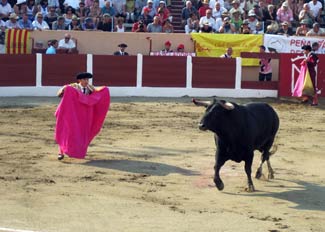Corridas: A Questionable Tradition in the 21st Century

As the Catalan sun begins to drop behind the Pyrenées, the shadow of the west half of Les Arènes, the bullfight stadium in Céret, looms over the ancient battle happening in the center of the arena. I feel as though I'm in someone else's body, living someone else's life. Who's life exactly, I can't quite be sure. But it's not mine. I don't attend regional férias on Saturday afternoons. And yet here I am, listening to the Spanish and Catalan catcalls coming from the audience, directed at the young matador in the ring. After two hours and six slaughtered bulls, I still can't understand how and why the tradition of bullfighting continues to exist.
Jean François Coste, vice president of the Association Des Aficionados Cérétans, an organization that puts on a large number of the bullfights in Catalonia and Spain, explains to me that the earliest evidence of bullfighting is found in caves scattered around the area, where stone writings and pictures show men chasing bulls. Elsewhere in Europe, bullfighting (or corridas and novilladas) was another popular style of man-versus- animal sport in Roman times. Tauroctony, or "killing of the sacred bull," is associated with the Greek and Persian god Mithras. Archaeologists have found hundreds of examples of stone depictions of Mithras killing an enormous white bull in ancient Mithrasion worship centers left behind from the 1st and 4th centuries.
In towns like Céret, the corridas and novilladas are part of the Féria, a three-day celebration that includes profuse amounts of alcohol ingested by hoards of older teens and young adults in the village center, while popular DJ's spin until 4 a.m. Call me crazy, but I'm pretty sure the corridas of the 4th century didn't include turntables.
Drunken crowds aside, I'm still working through the ethical injustice between the men and bulls as I leave the corrida. I've seen more bloodshed today than in my entire life, and yet it wasn't displayed as such. Instead, it was presented as a festive and cultural exhibition, intended as amusement and celebration for all ages. As I understand it, the only men allowed to face the bull are the toreros, the matadors and the picadors, their allies on horseback. Not only have the matadors gone to uniquely designed schools, where they learn the "art" of bullfighting, but, as Coste informs me, for a man to be considered a professional matador, he must kill at least 25 bulls.
While a bull may be eight times the size of a man, the taureau doesn't enter the ring with two "helpers," another man on horseback with a spear, and a sword. It hasn't gone to school to fight a matador and it doesn't have to kill 25 people to be considered a professional bull. Size may be its advantage, but it lacks the logic, professionalism and training of its opponent. Rather than seeing corridas as "animal cruelty" or "barbarism," organizers portray them as a cultural tradition, which creates a reason to protect and preserve them. Moreover, mixing blood, beer and house music into one weekend and calling it a "festival" is a savage attempt to capitalize by any means of spectacle.
I am grateful for the experience and feel privileged to have seen for myself a traditional bullfight. That being said, what I am most grateful for is the opportunity to question why these fights still exist and wonder if there isn't a more humane option.
Recent Posts
The Cloth of the Sun by Su Kim
The Sculptor and his Wife by Mary Barczak
The Language Barrier by Jim Cameron
The Sixth Sense: Understanding by Christina Cocca
Bastille Day Bees by Annie Petersen
Reaching New Heights by Sarah Raghubir
Vive Perpignan by Chelsea Boone
The Changing Collioure Art Scene by Ariana Bacle
Having a Boule with Pétanque by Kristin O'Brien
Corridas in the 21st Century by Victoria King
Controversy Fermenting? by Marika Washchyshyn
A Different Culinary Landscape by Simon Arseneau
Student Pages
Simon Arseneau
Ariana Bacle
Mary Barczak
Chelsea Boone
Jim Cameron
Christina Cocca
Justine Dhollande
Su Kim
Victoria King
Kristin O'Brien
Annie Petersen
Sarah Raghubir
Alexis Sanchez
Maegan Simmons
Marika Washchyshyn
About the Program
Fifteen college students came from North America to Perpignan, France, in June 2011 to produce these videos and stories. To find out more, read a welcome letter from program director Rachele Kanigel, meet the program faculty and explore the 2010 website.

